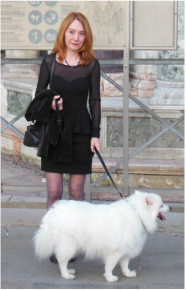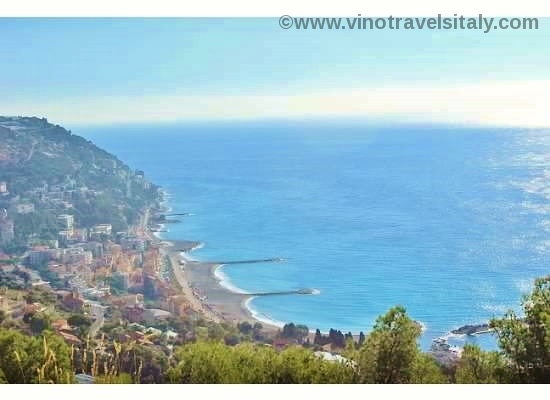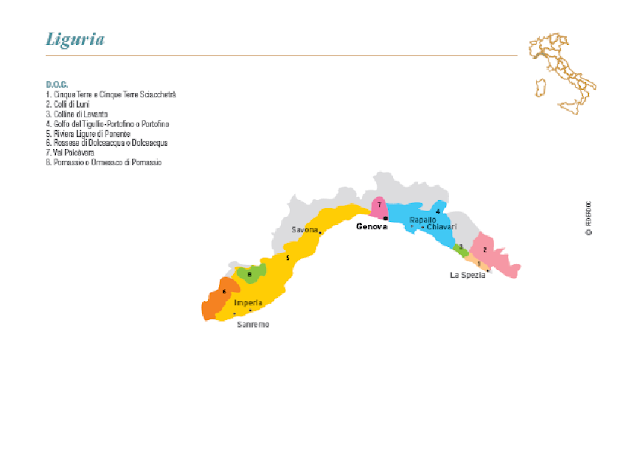One of my favorite parts of blogging is meeting folks virtually around the world and even better if I get to meet them in person. I came across the "Prosecco Project" run by Maree Church some time back and thought she'd be the perfect person to share her knowledge and recommendations on the sparkling wines not only including prosecco, but those around Italy that she has fallen in love with.
Where are you originally from and what brought you to Italy?
Where are you originally from and what brought you to Italy?
 | ||||||||||||||||||||
What made you choose Le Marche to settle down in?
My husband and I first visited Le
Marche in about 2004 in search of some wines to import. We had met a
wine maker at the San Francisco Fancy food show, and scheduled a
visit to see his winery and taste his wines. Our first introduction
to the region was staying in the beautiful area of Portonovo, south of
Ancona, where the mountains meet the sea. I was overwhelmed with the
beauty of the setting. The next day we drove inland to visit the
winery near Cingoli, a hill town nicknamed the balcony of Le Marche.
After driving through the rolling hills dotted with olive groves and
vineyards, I was sure this was the place that I wanted to call home.
Once we started to look for a house, however, it took us 5 years to
find the one. After five years of living in Le Marche, I am more
convinced than ever that I choose the right area to live. The people
are kind, friendly, and always willing to go out of their way to help
you. The views are spectacular with the Apennine mountains on one
side and the Adriatic on the other and beautiful panoramas of hill
towns in between. Of course, I can't forget the wine. I did not
really know anything about Verdicchio until my fist trip to Le
Marche, and since then it has become one of my favorites. It makes
an amazing metodo classico.
Are you currently still involved in
the wine industry?
Starting a wine import business grew
out of my love for Prosecco and my inability to find the same quality
of Prosecco in the US that I drank in Venice. That truly was what
drove me to get into the business. My professional background is in
a totally different industry, and I continue to do management
consulting for US clients even from my home in Italy. When my
husband and I moved to Italy, we gave up our American import license.
So, my involvement in the wine industry at the moment is mostly as a
consumer, and I do like to consume it. While we are back in the
states, however, we are hoping to help find importers for the wines
of a couple of our friends. And, someday soon, I am hoping to take
the sommelier courses and improve my wine knowledge.
What sparked your love of Prosecco?
Ah, Prosecco. I have always loved
sparkling wine. It is my passion. When I first tasted Prosecco, of
course, the setting was perfect, a Cafe in St.Mark's square. Music
playing. A perfect May evening. What was not to like? I think I
spent that entire trip searching for the next glass of Prosecco. It
did take a couple of years, however, before I actually made the
pilgrimage to Valdobbiadene in search of a Prosecco to import.
There, through serendipity, we were directed to a small, third
generation family winery, Zucchetto. It took a while to go through
the label approval process, and our first shipment to the states
ended in a disaster and never made it to us. But we persisted and
finally, we had Prosecco to sell, and just as importantly, to drink.
It was a very big hit with our customers as it has always been made
with less sugar than most prosecco. While we cannot import the
Zucchetto Prosecco anymore, we still go to visit the family and buy
Prosecco to take home to Le Marche. It remains one of my favorites.
Unfortunately, there is not a major importer of Zucchetto in the US
at the present time.
Any particular favorite prosecco
producers?
As I stated earlier, Zucchetto remains
one of my favorites. It is still a small, family run winery
producing about 60,000 bottles per year of extra dry, brut and
cartizze and a still wine. I have come to appreciate the wines of
Bisol in my time in Italy and I search them out when I am looking for
a Prosecco here in the states. They have a very nice metodo
classico from the glera grape, but I have not found it in the US.
Ruggieri's Guistino Bisol is also an amazing Prosecco. You may
notice that all of these are from Valdobbiadene. I definitely prefer
the wines from the original Prosecco area of Valdobbiadene and
Conegliano to the newer wines from the Treviso area. There is just a
different quality to the wines in my opinion. I will even go so far
as to say that in general, I really am partial to wines grown around
the village of Fol in the Valdobbiadene area. There is just
something in the terroir there that sets these Prosecco's apart.
Why are the Proseccos in the US not
up to par with Italy?
In terms of what Prosecco is available
in the US, I do believe that much of it is inferior to what I would
find in Italy. I believe a lot of importers and their clients here
in the wholesale and retail markets are motivated by price, and
generally, the DOC wines are going to be available for a
significantly lower price than the DOCG wines. And if you look at the
wines in your local liquor store or in the supermarket you will most
likely find they are from Treviso. However, that said, I have
noticed in my last visit to Valdobbiadene that it is becoming like
Napa, with more vines everywhere. Since the demand for Prosecco has
grown, producers are planting more in an effort to keep up. One
producer told us that the prevalence of the newer vines has changed
the nature of the Prosecco and even many wines from Valdobbiadene are
not what they once were. As long as the American consumer is happy
with the mediocre Prosecco generally available, which in my
experience is the case, I don't think there will be any movement to
improve the quality of the imports any time in the near future.
Other thoughts on the other sparkling wine of Italy?
Living in Le Marche, I have had the
opportunity to taste many wonderful sparkling verdicchios. The grape
is being used to make both the charmat method and metodo classico.
If I had to choose one sparkling verdicchio as a favorite, it would
be the Colonnara Ubaldo Rosi, a wine aged in the bottle for five
years. This wine has been declared the third best sparkling wine in
Italy and the best south of the Po River. It is amazing!
Unfortunately, it is not yet available in the US, but I am optimistic
that it will be soon.
 |
| 100 year old machine Maree discovered at the Colonnara winery to infuse carbon dioxide to produce sparkling wines |
In Italy there are so many wonderful
grape varieties and many more sparkling wines made throughout the
country from a great variety of grapes. In Le Marche, for example,
they are also making sparkling wine from the Pecorino grape. Yes,
Pecorino is a wine variety not just a cheese. I still remember the
time several years ago when I asked for a bottle of Pecorino in a
very well known Venice restaurant and they brought me cheese and not
the wine. When I voiced my surprise and reiterated that I wanted
wine, the sommelier admitted that he never heard of Pecorino wine. I
think the most distinctive and particular, as the Italians say,
sparkling wine I have tasted came from Piemonte. It is from the
Erbaluce grape, an ancient grape variety grown in the area of Caluso.
The nose of this wine is not of citrus or flowers, but the earth and
sage and rosemary. It is quite interesting, but I must admit it is
not on my list of favorite wine varieties.
Of course, no discussion
of Italian sparkling wines would be complete without mentioning
Ferrari. Since arriving back in the states, the Ferrari Brut Rose
has become a favorite, and I am sure to order it whenever we go out
to dinner at our favorite Italian restaurant.
Pictures compliments of Maree Church.
Pictures compliments of Maree Church.












